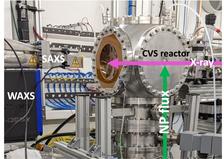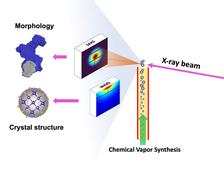Experimental set-up (CVS reactor) to probe nanoparticle formation in situ by simultaneous SAXS-WAXS measurements during chemical vapor synthesis at the PETRA III beamline P62 at DESY. (Credit: NPPT/Univ. of Duisburg-Essen)
In their recent work, researchers from the University of Duisburg-Essen (Germany) report on a major step forward in unravelling the formation of nanoparticles during gas-phase synthesis. Their study, published in the journal Chemistry of Materials, provides unique insights into nanoparticle growth processes made possible by the use of the brilliant X-ray beams from PETRA III.
Materials based on nanoparticles find a wide range of applications, for example, in catalysis, energy storage and medical diagnostics. The chemical and physical material properties strongly depend on the particle characteristics, such as crystal structure, degree of agglomeration and especially size. Based on a detailed mechanistic understanding of the underlying formation, it is therefore possible to tailor nanoparticles for special applications by controlling the particle synthesis conditions.
“Chemical Vapor Synthesis (CVS) is a gas-phase technique that enables scalable production of nanoparticles with high tuneability of these structural characteristics”, reports Markus Winterer, head of the Nanoparticle Process Technology (NPPT) group at the University of Duisburg-Essen. “Despite extensive research efforts to understand the underlying formation mechanisms, direct experimental observations during this established synthesis method, i.e., in situ, are still lacking.”
“In our research, we directly probe the formation of nanoparticles during CVS in situ, by using PETRA III’s X-ray beams, to follow this process over a length scale range from Angstrom up to 100 nanometres”, says Shradha Joshi. She is the first author of the article and PhD candidate in the NPPT group. However, such in situ experiments are very challenging since nanoparticles in the gas phase are highly dilute, because the number densities and scattering power are 105 times lower than, e.g., in typical powder samples. Additionally, high temperatures (700 – 1000 °C) and vacuum conditions are required for this X-ray scattering experiment.
“These challenges were solved using the PETRA III beamlines P21.1 and P62. Both are ideally equipped to host our extensive set up for advanced X-ray scattering of dilute nanoparticle aerosols”, says Martin Schroer, scientist in the NPPT group. “The high brilliance of PETRA III, along with advanced X-ray detectors for photon counting, allowed us to capture even subtle transitions of nanoparticles in a proof-of-principle experiment with tin oxide (SnO2) as a model system during the gas phase synthesis and enables novel insights into the CVS process”, remarks Markus Winterer.
The formation of crystalline nanoparticles during CVS was discovered by in situ X-ray diffraction measurements performed at beamline P21.1. “To the best of our knowledge, this is the first in situ X-ray diffraction experiment of nanoparticles probed under such conditions in the gas phase. Unexpectedly, the freshly-formed particles exhibit an already crystalline structure at such high temperatures,” explains Shradha Joshi.
“We observed the nanoparticle formation in situ over a wide-length scale simultaneously by small- and wide-angle X-ray scattering at beamline P62 – getting access into the development of crystal structure, particle morphology and microstructure”, says Martin Schroer. “Although there are no drastic variations in particle and crystallite size with temperatures, the overall clustering of particles and their size distributions are significantly influenced by temperature and the overall pressure.” These pioneering experiments show considerable potential for the future in uncovering complex growth mechanisms of nanoparticles in the gas phase and engineering them for specific applications. Further experiments would benefit greatly from the higher brilliance of PETRA IV, the upgrade of PETRA III.
Reference:
Shradha R. Joshi, Martin A. Schroer, and Markus Winterer, In Situ X‑ray Scattering of Tin Oxide Nanoparticles during Chemical Vapor Synthesis, Chem. Mater. 37, 15 (2025), DOI: 10.1021/acs.chemmater.5c00848








